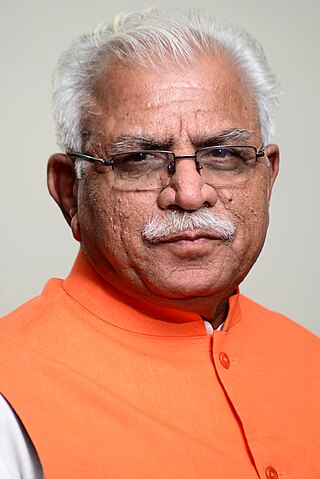This article needs additional citations for verification .(November 2016) |
Khattar is a surname found among the Aroras and Jats of India and Pakistan. [1] [2]
This article needs additional citations for verification .(November 2016) |
Khattar is a surname found among the Aroras and Jats of India and Pakistan. [1] [2]

Sohawa is an administrative sub-division (Tehsil) of the Jhelum District, situated in the Punjab province of Pakistan, located in the northwestern part of the district. One sign of Sohawa is the toll plaza by the name of 'Tarakki' on the Grand Trunk Road. The main bazaar of Sohawa attracts people from nearby villages.

Jind is one of the largest and oldest city in Jind district in the Indian state of Haryana. It is administrative headquarter of Jind district. Rani Talab is the main destination for tourists while Pandu Pindara and Ramrai are the main religious spots, attracting devotees for the holy bath during Amavasya.
Sidhu is a Punjabi Jat clan found in Punjab.
Kharal is a Punjabi tribe predominantly found in the Sandal Bar region of Punjab, Pakistan, with significant numbers also present in Pind Dadan Khan, Muzaffargarh, Multan, Bahawalpur and further south to Sindh.

Mirza Sahiban is one of the four popular tragic romances of the Punjab. The other three are Heer Ranjha, Sohni Mahiwal and Sassi Punnun.
Atwal is a Jat clan and a family name of Sikhs.

Moga district is one of the twenty-two districts in the state of Punjab, India. It became the 17th district of Punjab State on 24 November 1995 cut from Faridkot district. Moga District is among the largest producers of wheat and rice in Punjab, India. People from Moga City and Moga District belong to the Malwa culture. The district is noted for being the homeland for a high proportion of Indian Punjabi expatriates who emigrated abroad and their descendents, which has given it the nickname of "NRI district".
Jat Sikh are an ethnoreligious group and a subgroup of the Jat people and the Sikh religious group from the Indian subcontinent. They are one of the dominant communities in the Punjab, owing to their large land holdings.

Haryanvi, also known as Bāngrū, is an Indo-Aryan language spoken primarily in the Indian state of Haryana, the territory of Delhi, and to a lesser extent the Pakistani districts of Pakpattan, Sahiwal, Okara, Bahawalpur and Multan within Punjab, Pakistan and numerous towns in Sindh as well. Haryanvi is considered to be part of the dialect group of Western Hindi, which also includes Khariboli and Braj. The Haryanvi language is written either in the Devanagari script in India, or with the Nastaliq variant of the Arabic script in Pakistan.
Pindi Gheb Tehsil is an administrative subdivision (tehsil), of Attock District in the Punjab Province of Pakistan, the capital is the town of Pindi Gheb.
The demographics of Rawalpindi District, a district of Punjab in Pakistan, has undergone significant changes over the years. It has been affected by turmoil in the surrounding districts.
Jat Muslim or Musalman Jat, also spelled Jatt or Jutt, are an ethnoreligious group and a subgroup of the Jat people, who are followers of Islam and are native to the northern regions of the Indian subcontinent. They are found primarily throughout the Sindh and Punjab regions of Pakistan, with a small population in Afghanistan. Jats began converting to Islam from the early Middle Ages onward and constitute a distinct subgroup within the diverse community of Jat people.
Ram Diwali is a locality in Faisalabad District, Punjab, Pakistan. It comprises four villages which are locally identified as Chak No. 112 JB, Chak No. 2 JB, Chak No. 3 JB and Chak No. 4 JB. The locality is situated on Sargodha Road and lies to the north of the city of Faisalabad, 5 kilometres (3.1 mi) away from Pakistan's M–3 Motorway, and is mainly inhabited by ethnic Punjabi Jats of the Randhawa clan. Prior to the Partition of British India in August 1947, the predominantly Muslim locality was also inhabited by Sikhs, who migrated to Amritsar after the creation of Pakistan. Other ethnic Punjabi Jat clans, namely the Gill and Sandhu, are also settled in Ram Diwali.
Hans is an eponymous Punjabi Arora clan of Khatri community found in India. It originates from the Sanskrit hams, meaning swan or goose. It is also a Jat clan. The name can also be found amongst the Bhangi (Chuhra) and Balmiki (Mirasi) castes.

The KanhaiyaMisl was one of the twelve misls of the Sikh Confederacy. It had been founded by Sandhu Jats.

Manohar Lal Khattar is an Indian politician serving as the 10th and current Chief Minister of Haryana since 2014. He is a member of the Bharatiya Janata Party (BJP) and a former RSS pracharak. He represents Karnal constituency in Haryana Legislative Assembly since 2014.

The Jat reservation agitation was a series of violent protests in February 2016 by the Jat people of North India, especially those in the state of Haryana, which "paralysed" the state for 10 days. The protestors sought inclusion of their caste in the Other Backward Class (OBC) category, which would make them eligible for affirmative action benefits. Besides Haryana, the protests also spread to the neighbouring states, such as Uttar Pradesh, Rajasthan, and the National Capital Region.
Khan Bahadur Chaudhry Sir Shahab-ud-Din Virk was a Punjabi lawyer and politician of British India.
Bhatti is a Punjabi clan of Rajputs and Jats. The Bhattis along with Bhuttos and Bhatias claim to have originated from the Hindu Bhati Rajputs.
Khattar is a Punjabi Khatri, not a Jat...
First, the Bengal army's 'martial' regiments of Gurkhas, Jat Sikhs and Punjabi Muslims increasingly took over ... Gakhar, Janjua and Khattar Jat.